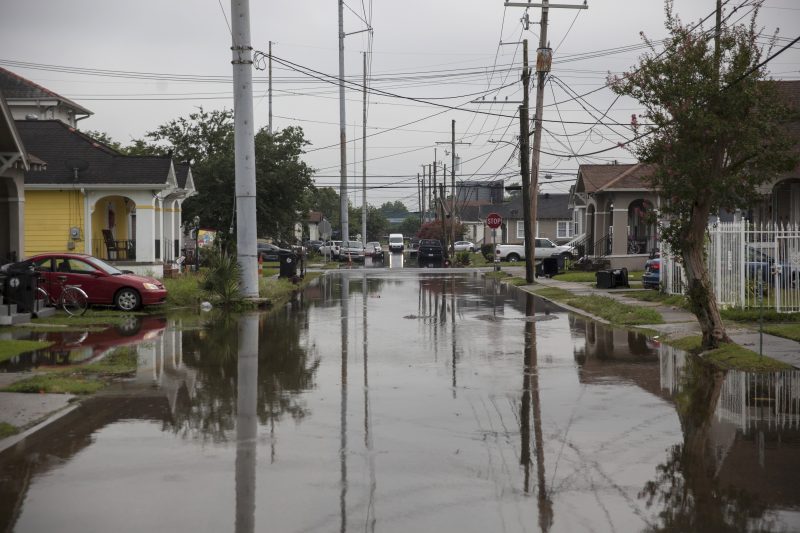Flooding, rains pound New Orleans ahead of potential hurricane
S Telemachus Street in New Orleans is submerged after flash floods struck the area early on July 10 (Seth HERALD)
New Orleans (AFP) – Tropical storm Barry barreled toward rain-soaked New Orleans Thursday as the city hunkered down for an ordeal that evoked fearful memories of 2005’s deadly Hurricane Katrina.
The system, which has already caused major flooding in the low-lying city, is expected to strengthen and “become a hurricane late Friday or early Saturday,” according to the US National Hurricane Center.
With Barry just 95 miles (152 kilometers) from the mouth of the Mississippi River, Louisiana Governor John Bel Edwards declared a state of emergency and two parishes called for mandatory evacuations for portions of their jurisdiction.
New Orleans Mayor Latoya Cantrell warned her city’s residents on Twitter Thursday to “review your plans, supply kit and stay updated with the latest forecasts.”
“The center of Barry will be near the central or southeastern coast of Louisiana Friday night or Saturday,” the NHC predicted in its 1500 GMT bulletin Thursday, forecasting additional strengthening “during the next day or two.”
Not only does the region face major flooding, but also the prospect of a swollen Mississippi River breeching the top of levees.
An official with the Army Corps of Engineers in New Orleans said levees south of the city were of concern, but that there appeared to be little risk for the city itself, according to CBS News.
On Wednesday, officials said the 118 pumps spread throughout the city were operating at “optimum capacity.”
In 2005, Katrina — the costliest and deadliest hurricane in US history — submerged some 80 percent of the city as New Orlean’s flood defenses gave way.
Best remembered for the devastation wreaked in New Orleans, Katrina also pounded other parts of the southern state of Louisiana as well as Mississippi and Alabama, leading to some 1,800 deaths and inflicting more than $150 billion worth of damage.
– Potential first –
If the storm becomes a hurricane as anticipated, it would be the first of the Atlantic season, which runs from June through November.
More than 16,500 locations were without power across the state Thursday morning, according to energy provider Entergy Louisiana.
Meanwhile, crews from the Louisiana Department of Transportation and Development erected barricades and cleaned out ditches and other debris ahead of the expected deluge.
A hurricane watch, which means that hurricane conditions are possible within the area, is in effect for the mouth of the Mississippi River to Cameron, Louisiana. A tropical storm warning, meaning tropical storm conditions are expected, was in effect from the mouth of the Pearl River to Morgan City, Louisiana.
Barry is expected to produce 10 to 15 inches (25 to 38 centimeters)of rain, with up to 20 inches in some areas, NHC said, and has already caused major flooding.
Residents could be seen wading through calf-deep floodwaters inundating city streets, and clearing debris deposited by the flooding from their lawns.
Offshore oil and gas operators in the Gulf were evacuated from platforms and rigs on Thursday, according to the US bureau of Safety and Environmental Enforcement.
New Orleans City Hall was also shuttered, as were Loyola University and a number of other educational facilities. Jefferson Parish schools were slated to close Friday.
Mandatory evacuations were ordered for parts of Jefferson and Plaquemines parishes, and voluntary evacuation in effect in Grand Isle, a populated barrier island, according to the NOLA.com news website.
The slow-moving storm system was traveling west at five miles per hour (9 kilometers per hour) as of the latest NHC bulletin and is expected to turn northwest Thursday night.
The Miami-based center noted that sustained winds had increased to near 40 mph and “a tornado or two” were possible Thursday or Friday night across southern portions of Louisiana and Mississippi.
Disclaimer: Validity of the above story is for 7 Days from original date of publishing. Source: AFP.


